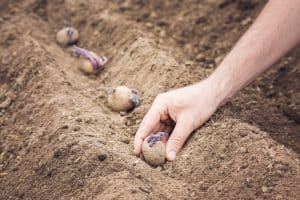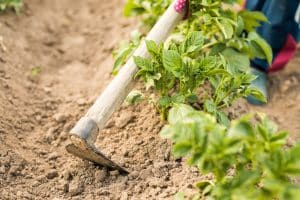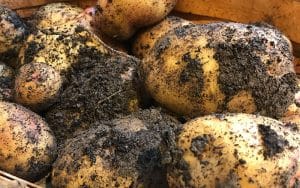How to grow potatoes UK
.
With over 500 different varieties of potato in the UK alone, potatoes are officially the nation’s favourite vegetable. So, you can be sure growing spuds will be a welcome addition to your school or community garden.
It’s not hard to see why spuds are a firm favourite. They taste great baked, mashed, and roasted. Plus, they’re rich in vitamin C and potassium, an electrolyte that aids healthy hearts, muscles, and nervous systems. The best bit? It's super easy to grow potatoes. In fact, you don’t even need a garden, they grow happily in large bags and pots, too!
Which type of potato should I grow?
There are three main types of potatoes to grow. And each is as delicious as the next, so you simply have to decide when you want to plant and harvest them. Let’s take a look at your options:
1. Early or ‘New’.
These are the earliest to crop, in June or July. However, they don’t keep well, so make sure you eat them fresh!
2. Second Earlies.
These take a few more weeks to mature and can be harvested in July and August. Again, these are best eaten fresh. Both of these early potatoes are firm and waxy, with a delicious nutty flavour. Plus, they’re great in salads...
3. Maincrop.
These take the longest to mature and can be harvested from August to October.
Once you’ve chosen which potatoes you’d like to grow, it’s time to get planting! Even better, why not plant all three for a brilliant succession of harvests?
How to grow potatoes?
Potatoes are grown from ‘seed potatoes’. These are available at most supermarkets and garden centres. They’re not fussy about soil type, as long as they’re in a sunny spot. But make sure they’re watered when the weather gets dry.
Step 1. Chit your potato.

Before planting, you must ‘chit’ your seed potato. This means letting the potato grow shoots and will, ultimately, give you a bigger crop. To do this, simply place your seed potatoes in a tray with the rose end facing upwards. Leave them standing in a cool, light spot, until shoots around 1-2cm long have grown. This can take up to six weeks.
Step 2. Get planting!
Dig a narrow trench about 10cm deep, and place your seed potato into it with the shoots facing upwards. Be careful handling the seeds, however, as they can be brittle. Leave around a 30cm gap between each seed potato. And if you’re growing multiple rows, leave around 60cm between trenches.
Step 3. Cover up.
Cover the seed potatoes with soil, filling the trench. It will help growth to scatter a high potash fertiliser over the trench, but this isn’t essential.
Step 4. Earthing up.
When you start seeing shoots poking through the soil, it’s important that you earth up. This protects the plants from colder weather. Simply pull up soil and cover the emerging shoots. This will stop your potatoes turning green. And, by the way, green means potentially harmful! Repeat this step until the shoots are well away from the original seed.
Step 5. Harvesting.
You’ll know your potatoes are nearly ready when their foliage turns yellow and begins to wither. Remove the foliage and compost, then wait another 10 days before digging the potatoes up. Simply lift them out with a garden fork, taking care not to spike the crop.

Where and how do you store potatoes?
Early potatoes are best eaten and cooked fresh. So it's best to harvest these as and when you want to eat them. Maincrops, however, can be stored for several months. Simply find a cool, dry, frost-free place, such as a garage, sack, or larder. The lack of light will prevent sprouting.
Make sure you're only storing dry, undamaged potatoes. Check them regularly throughout winter for rot, and aim to finish them before early spring.
Plus, make sure you wash and scrub your potatoes before cooking them. And never eat them raw! Potatoes contain a chemical called solanine. This can cause severe stomach upsets.
And there you have it! Potatoes, grown in your very own school or community garden. Be warned, however, there might be some arguments over who gets to take them home. They are the nation’s favourite veg, after all. We suggest turning them into a delicious meal that everyone can share.

